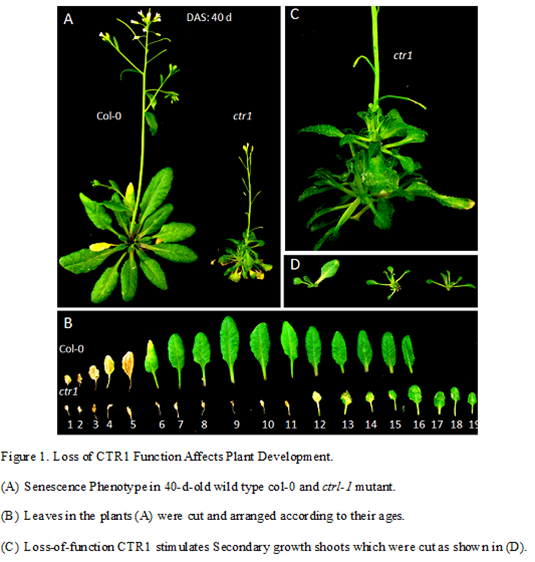|
|
|
|
| Locus name | AT5G03730 |
| Alias | CTR1 | | Organism | Arabidopsis thaliana | | Taxonomic identifier | [NCBI] | | Function category | Hormone response pathway:ET | | Effect for Senescence | promote | | Gene Description | Homologous to the RAF family of serine/threonine protein kinases. Negative regulator in the ethylene signal transduction pathway. Interacts with the putative ethylene receptors ETR1 and ERS. Constitutively expressed. | | Evidence | Genetic evidence:Mutant [Ref 1] | | References | 1: Kieber JJ, Rothenberg M, Roman G, Feldmann KA, Ecker JRCTR1, a negative regulator of the ethylene response pathway in Arabidopsis, encodes a member of the raf family of protein kinases.Cell 1993 Feb 12;72(3):427-41 | | Gene Ontology | | | Sequence | AT5G03730.1 | Genomic | mRNA | CDS | Protein
AT5G03730.2 | Genomic | mRNA | CDS | Protein
|
| | Mutant name |
ctr1-1 | | Mutant/Transgenic |
mutant | | Ecotype |
Col-0 |
| Mutagenesis type |
EMS |
Ortholog Group  | |
| | Ortholog Groups: OG5_149590 | |
Cross Link  | |
| |
Mutant Image  | |
| | Loss-of-Function CTR1 Leads to Early Senescence Previous studies suggested that ctr1 mutant has a wild-type timing of senescence under standard growth conditions. In fact, just based on the observation of the whole plants, it is difficult to found the difference between the ctrl mutant and wild type Col-0 (Figure 1A). However, when all the rosette leaves were detached and arranged according to their ages, it is easy to find that most of ctrl leaves died (leaf1-13). By contrast, only five leaves of 40-d-old Col-0 (Leaf 1-5), including cotyledon leaves, died and one leaf became yellowing (Leaf 6) (Figure 1B). Interestingly, many rosette-like leaves, which masked our observation, were found in the stem of ctrl plants (Figure 1 C and 1D). Furthermore, ctr1 mutant leaves showed significant chlorosis when excised and placed in the dark in air for several days, to a level approaching that observed in wild type leaves placed in ethylene. Since chlorosis is a yellowing of leaf tissue due to a lack of chlorophyll, we conclude that loss of function of the CTR1 genes promotes senescence process upon darkness treatment. Together, these results demonstrated that loss of function of CTR1, as a negative regulator of ethylene signaling pathway, leads to early senescence.More interestingly, ctr1 mutants showed much lower numbers of yellow leaves upon treatment with ethylene, compared with the wild type Col-0 plants. Since negative feedback loop existed in the ethylene signaling pathway, losses of function of CTR1 maybe activate negative regulators that lead to insensitive to exogenous ethylene, which maybe one of the reasons why constitutively activating the ethylene signaling pathway in ctr1 inhibited the onset of leaf senescence. | |
|  |
| | Localization | nucleus | | Evidence | SUBAcon | | Pubmed ID | 23180787 |
|
